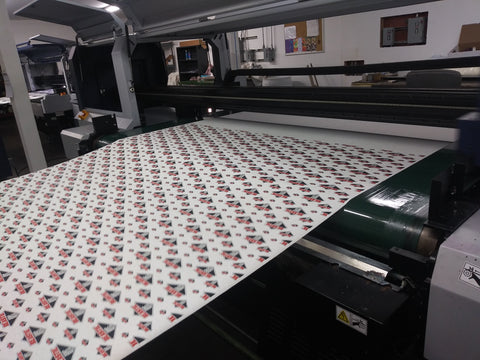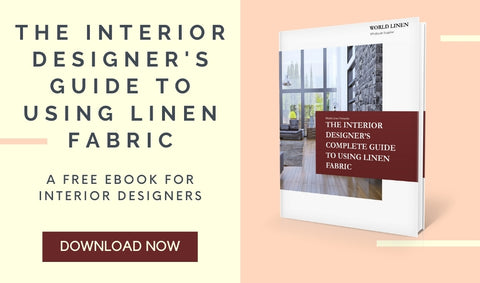Transforming your creative vision into reality requires more than just selecting the right materials. It demands strategic sourcing and meticulous planning.
When it comes to procuring printed linen fabric wholesale, every decision counts. Whether you’re a seasoned designer or a budding entrepreneur, navigating the textile marketplace can be daunting. Here are five indispensable tips to streamline your shopping experience and ensure your project goes according to plan:
- Work with a supplier or manufacturer when possible
- Learn more about the supplier’s dyeing and printing process
- Inquire about turnaround times
- Choose domestic suppliers
- Check references and evaluate customer service
Work With A Supplier Or Manufacturer When Possible
Costs can escalate when you must buy linen fabric in large quantities, and if you’re in need of bulk amounts of fabric, you’re likely looking for wholesale partners.

You have a couple different options when searching for linen fabric wholesale. You can work with a supplier or manufacturer, or work with a distributor. The biggest difference between a supplier and distributor is cost.
When you work with a supplier or manufacturer, you get the benefit of purchasing large amounts of fabric at a reduced cost. The best suppliers will offer additional benefits as well, including customization options and shipping times that meet your deadlines.
On the other hand, wholesale fabric distributors act as a middle man. Once they receive the fabric, they mark up the price before selling it to an end-user, such as a retail fabric store or you as the designer.
One situation where working with a distributor may be better than working with a supplier is if you don’t need high quantities of fabric. Some suppliers will require fabric quantity minimums. Distributors typically don’t. However, if you’re looking for wholesale fabric because you need large quantities for a project, you’ll likely meet those order minimum requirements.
Learn More About The Supplier’s Dyeing And Printing Process
The quality of your project is everything. Your clients are relying on you to deliver excellence, so it’s important to learn everything you can about a supplier’s dyeing and printing process to ensure you deliver the highest quality of product.
The top suppliers will offer you the ability to customize your linen fabric to meet the needs of your project. Suppliers will also use the most updated and accurate equipment to ensure the finished product meets the highest standards of quality.
Here are a few qualities of a top fabric supplier:
- You can create your own custom dye lot. Whether you’re creating a piece of furniture, drapery or outdoor pieces, it’s important to ensure the color is exactly what you envision. To do this, you should create your own custom dye lot, which ensures greater stringent controls are added so that the mill can meet specifications. The results are repeatable and reliable with a maximum variation of 3% to 5%.
- Never rely on the manufacturer’s website for color. You may be working with a top manufacturer in the linen fabric industry. But your computer screen may appear differently than another designer’s computer screen, and the color you’re expecting might not be the color that you get. Instead, request a fabric swatch, which will give you a better idea of what to expect.
- Look for customized printing options so you can get the design you want. While a top linen fabric supplier may offer a variety of printed fabrics from which to choose, you may want to design your own look. Working with a company that allows you to provide your own design can open up the possibilities of what you can offer your clients. Let’s dive into this further below.
So what are your options when it comes to customizable printing? Some linen fabrics will offer rotary/flat bed printing, digital printing or both.
Rotary/flat bed printing is a direct-to-fabric printing technique where the image is engraved on precision cut stencils, also known as screens. Multiple screens can be used to create a multi-color design and can produce vivid colors and intricate designs on your fabric. Crisp lines and detailed images are created using screen printing, allowing inks to penetrate the fabric and hold color better and longer.
Digital printing on fabric is also known as DTG, or direct-to-garment printing. Digital printing is any inkjet based method of printing colorants onto fabric. This process allows for lower minimums, eliminates screen charges and removes the need for screen storage.

Inquire About Turnaround Times
When considering suppliers for your printed linen fabric needs, it's crucial to inquire about their turnaround times. Understanding how quickly a supplier can fulfill your orders is essential for meeting project deadlines and maintaining client satisfaction.
Reliable turnaround times ensure that you receive your materials promptly, allowing you to move forward with your projects efficiently.
When discussing turnaround times with potential suppliers, ask about their production processes and capacity. Inquire about their typical lead times for both standard and custom orders.
It’s also important to clarify how they handle rush orders or expedited shipping requests, since these may be necessary for time-sensitive projects now or in the future. By gaining insights into a supplier's turnaround times, you can make informed decisions and plan your project timelines accordingly.
What can help ensure you have a faster turnaround time? Where that company’s manufacturing facilities are located. Let’s look at this shopping tip next.
Choose Domestic Suppliers
Opting for a domestic supplier can be an advantage when it comes to turnaround times. Domestic suppliers often offer shorter shipping distances and faster delivery times compared to international counterparts. With reduced transit times, you can expedite the receipt of your printed linen fabric, allowing you to start and complete your projects on schedule.
Choosing a domestic supplier not only supports local economies but also provides logistical advantages that contribute to meeting tight deadlines with ease.
There are additional advantages to choosing a domestic supplier over a foreign-based supplier. Partnering with a domestic linen supplier also ensures a more direct line of communication. This accessibility reassures clients that any queries or questions you have will be promptly answered.
Communication hurdles and time zone disparities are minimized, and there’s less risk of encountering delays due to customs-related issues when working with a supplier based in the United States.
You even have the option to go onsite to check on your order, which could be important if you are customizing a significant amount of fabric for a large client. Should an order be mishandled, you’re likely to have more resource options domestically.
Check References And Evaluate Customer Service
From the very first interaction with a supplier, you can gain valuable insights into how your entire experience will unfold. Pay close attention to their responsiveness, professionalism and willingness to address your inquiries promptly and thoroughly.
A linen company that prioritizes clear communication and attentive customer service from the outset is likely to uphold these standards throughout your collaboration.
One effective way to gauge a supplier’s reliability and reputation is by checking references from other designers or businesses who have worked with them before. Reach out to colleagues or industry contacts who have experience with the supplier you're considering. Inquire about their overall satisfaction with the quality of products, adherence to deadlines and the level of support received throughout the process.
Don't hesitate to directly request references from the supplier. A reputable company will readily provide contact information for satisfied clients who can attest to their capabilities and reliability.
By conducting thorough reference checks and evaluating customer feedback, you can make an informed decision and choose a supplier that aligns with your project requirements and expectations.





